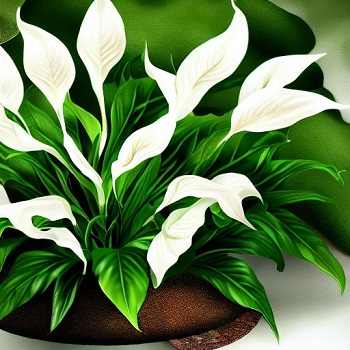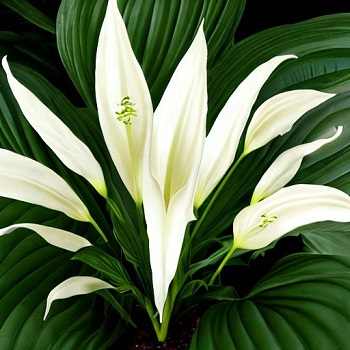Peace lilies (Spathiphyllum) are renowned houseplants known for their glossy, graceful leaves and stunning white flowers. To ensure their well-being and vitality, it is crucial to understand how to water peace lilies correctly. These plants thrive when the soil remains consistently moist, but it’s important to avoid overwatering or allowing standing water. In this comprehensive guide on how to water peace lilies, I will provide detailed instructions to ensure their optimal growth. By following these guidelines, you can ensure that these exquisite plants flourish and thrive for an extended period.
Understanding the Watering Needs of Peace Lilies
In soil that is equally wet but not saturated, Peace lilies do best. To stop root rot, you need to find the right mix. Here are some key things to think about:
1. Check Soil Moisture
Put your finger into the dirt up to the first joint to find out when to water your peace lily. If the dirt feels dry at that depth, the plant needs water.
2. Watering Frequency
In general, you should water peace flowers once a week. But things like weather, humidity, and the size of the pot can change the regularity. Closely watch the plant and make changes to the watering schedule as needed.
3. Watering Method
For peace lilies, it is best to water them from the bottom up. Put the pot on a tray or pan filled with water so the plant can drink through the drainage holes. This method makes sure that the dirt gets enough water without getting too wet.
As an Amazon Associate we earn from qualifying purchases.
Table of Contents
How to Water Peace Lily Houseplants

Now let’s look at how to water peace lilies the right way, step by step.
Step 1: Prepare the Water
Use filtered or pure water for your peace lilies. If you have no other choice but to use tap water, let it sit out for 24 to 48 hours to get rid of chlorine and other chemicals.
Step 2: Choose the Right Container
Choose a pot with drainage holes in the bottom to make sure water flows well and doesn’t pool.
Step 3: Watering the Plant
- Set the pot on a tray or bowl to catch any water that spills out.
- Slowly pour water into the pan, letting the plant soak up water from the bottom.
- Keep adding water until the dirt is evenly wet, but don’t water too much.
- Give the plant about 10 to 15 minutes to soak up the water, and then pour out any extra water in the saucer.
Make sure the pot has good drainage and isn’t sitting in water.
Step 4: Observe and Adjust
After you water your peace lily, look for signs that it is getting too much or too little water. Change how often and how much you water a plant based on how it responds. Remember that it’s better to put peace flowers under water than over water.
Signs of Properly Watered Peace Lilies
When you water your peace lily the right way, it will show these signs that it is getting enough water:
- Leaves that stand up straight: The plant’s leaves should not be sagging or dying.
- Peace lilies that are getting enough water have thick, bright green leaves.
- Peace lilies will keep putting out new leaves and flowers as long as they get enough water.
Signs of Overwatering and Underwatering
It’s important to recognize the signs of overwatering and underwatering in peace lilies. Here are key indicators to watch out for:
Overwatering:
- Leaves turn yellow: When peace lilies get too much water, the leaves may turn yellow and feel soft and mushy to the touch.
- Root rot: Too much moisture can cause dark, mushy roots and a bad smell.
- Plants that get too much water may not grow or may not grow any new leaves.
Underwatering:
- When peace lilies are underwater, their leaves will droop and wilt to show that they need water.
- Brown and crispy leaf edges: When leaves don’t get enough water, the edges can turn brown and crispy.
- Peace lilies can grow and develop more slowly if they don’t get enough water.
Peace Lily Watering Tips

To ensure optimal care for your peace lilies, consider the following tips:
1. Water Quality
Peace flowers don’t like chemicals in tap water, like fluoride, which can hurt them. Use filtered or pure water as often as you can. You could also let the tap water sit out for 24 to 48 hours to get rid of the chlorine and other chemicals.
2. Humidity
Peace flowers like it when it’s wet. You can increase humidity by misting the leaves often or by putting the plant on a tray filled with water and pebbles.
3. Potting Mix
Pick a potting mix that drains well and holds moisture without getting soggy. Peace lilies often do well in a mix of peat moss, perlite, and vermiculite.
4. Temperature and Light
Between 65°F and 85°F (18°C and 29°C) is ideal for peace lilies. Don’t put them in cold drafts or full sunlight, as this can make them stressed and change how much water they need.
5. Observation is Key
Watch your peace lily closely for any signs that it needs more water. Watch for changes in the color, texture, and general look of the plant’s leaves. This will help you find any watering problems quickly and fix them.
Growing Peace Lily In Water

A popular way to grow a peace lily is in water, which can be a great choice to growing it in dirt. Here’s what you need to do:
- Select a good container: Choose a pot that is deep enough to hold water and wide enough to let the roots of the peace lily grow. For this, a glass vase or jar works well.
- Get the water ready: For the best results, use purified or pure water. Let the water sit out for 24 to 48 hours to get rid of any chlorine or other chemicals.
- Put the peace lily in a bowl of water: Carefully take the peace lily out of its pot and rinse the roots gently to get rid of any dust. Put the plant in the pot so that the water covers the roots.
- Keep the water level up: Add water to the jar often to keep the water level the same. Make sure the roots are always wet, but don’t cover the leaves fully.
- Give off enough light: Put the jar somewhere that gets bright light from the side. Peace lilies do best in bright places, but they should not be in full sunlight.
- Change the water often. Replace the water in the pot every one to two weeks to keep it from getting stagnant and to keep the plant healthy.
How Often to Water a Peace Lily

Peace lilies like dirt that stays wet, but they don’t do well in water that just sits there. Here’s a general rule for how often you should water your peace lily:
- Check the soil’s moisture by sticking your finger into it up to the first joint. If the dirt feels dry at that depth, the plant needs water.
- Watering how often: In general, peace flowers need watering once a week. But this can change based on things like temperature, humidity, and the size of the pot. Closely watch the plant and make changes to the watering schedule as needed.
- Watering technique from the bottom up Place the pot on a tray or dish filled with water and water from the bottom up. Let the water get to the plant through the holes. After about 10 to 15 minutes, throw away any extra water.
- Check out the plant: Look at the leaves of the plant. If they start to droop or wilt, it could mean that the peace lily needs water. Change how often you water the plant based on how it responds.
The Best Way to Water Your Peace Lily
Using the bottom-up method to water your peace lily is the best way to do it. Here’s what you need to do:
- Fill a tray or saucer with water. Put the pot on top of the full tray or saucer. The water level should be lower than the holes in the bottom of the pot.
- Let the plant drink up water: The peace lily will take in water through the holes, which will keep the roots moist. Give the plant about 10 to 15 minutes to sit in the water.
- Throw away any extra water: When the time is up, take the pot off the tray and throw away any extra water. It’s important not to let the plant sit in water for too long.
- Keep track of the plant: Watch the peace lily for any signs that it is getting too much or too little water. Change how often and how much you water a plant based on how it responds.
When and How to Water Peace Lily Plants:
To water peace lily plants effectively, follow these steps:
- Check the soil’s moisture by sticking your finger into it up to the first joint. If the dirt feels dry at that depth, the plant needs water.
- Watering how often: In general, peace flowers need watering once a week. But things like weather, humidity, and the size of the pot can change the regularity. Change how often you water the plant based on what it needs.
- Apply water from the bottom up: Put the pot on a tray or saucer that has water in it. Let the water get to the plant through the holes. About 10 to 15 minutes later, throw away any extra water.
- Check out the plant: Watch for signs that the peace lily is getting too much or too little water. Change how often and how much you water a plant based on how it responds. Remember that it’s better to put peace flowers under water than over water.
How to Grow and Care for Peace Lily Plants
To grow and care for peace lily plants, follow these guidelines:
- Peace flowers like bright light that comes from the side. Put them somewhere with filtered sunlight or just a few feet from a window.
- Temperature: Peace flowers do best between 65°F (18°C) and 85°F (29°C). Don’t let them be in the way of cold drafts or big changes in temperature.
- Watering: Keep the dirt wet, but don’t water it too much. Use the bottom-up way to water your plants, and change how often you water them based on what they need.
- Peace flowers like a lot of water in the air. To raise the humidity, mist the leaves often or put a tray of water near the plant.
- Fertilize peace flowers once a month during the growing season with a balanced, water-soluble fertilizer. Follow the directions on the package to get the right amount of water.
- Pruning: Take off any yellow or brown leaves or flowers that have died to encourage new growth. Cut back excess or straggly stems to keep the plant’s shape.
- Repotting: Repot peace lilies every one to two years, or when the roots get too close together. Use potting soil that drains well and a pot that is a little bigger than the one you are using now.
FAQ’s
Should I water peace lily from top or bottom?
People have different ideas about whether you should water a peace lily from the bottom or the top. Both ways have their pros and cons, so it all comes down to personal taste and what the plant needs. Here’s what you need to know about each method:
Bottom watering includes putting the pot on a tray or pan filled with water and letting the plant get water through the holes at the bottom of the pot. Bottom-watering peace lilies can be helpful because it keeps the roots from getting too much water and lets the roots take in water as needed.
To bottom water a peace lily, follow these steps:
- Fill a tray or pan with water, making sure the water level is below the pot’s drainage holes.
- Put the pot on the tray so that the water can drain through the holes in the bottom.
- Leave the pot on the tray for 10 to 15 minutes to let the water soak into the roots.
- Remove any extra water from the tray so the plant doesn’t get too wet.
Bottom watering is a safe way to water plants because it reduces the chance of overwatering, which can cause root rot. It also keeps water from splashing onto the leaves, which can leave marks or cause diseases caused by fungi.
- Top watering is when you pour water right on the surface of the dirt or water the plant gently from above. This method makes it easier to control where the water goes and can help clean the plants’ leaves.
To top water a peace lily, follow these steps:
- Use a watering can or a gentle stream of water to pour water directly on the soil surface, avoiding the leaves as much as possible.
- Be careful not to overwater the plant. Water it until the soil is fully wet.
- Allow any extra water to drain out of the pot.
Top-watering can be easy, and you can see how much water the plant is taking in. But you have to be careful not to overwater it or let water build up on the leaves, which can cause diseases and damage to the leaves.
Conclusion
Peace lilies need the right amount of water to stay healthy and strong. By following the steps in this detailed guide here on how to water peace lilies, you can ensure that your plants receive the appropriate amount of water without the risk of overwatering or underwatering. It is crucial to monitor the soil’s moisture level, select the appropriate watering method, and adjust the frequency of watering according to the plant’s requirements. With proper care and attention, your peace lilies will flourish, adorning your home with their beauty for many years to come.
Related Posts:
Are Peace Lilies Toxic To Cats?
Peace Lily Spiritual Meaning: Symbol, Feng Shui, Benefits (uk)
Are Peace Lilies Toxic To Dogs?
What Is the Meaning Behind White Calla Lily Flowers (Occasions To Send Them)
© 2024 Lotusmagus.com. All rights reserved. This content is protected by copyright. Visit Lotusmagus.com for more information.
